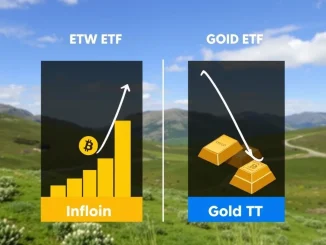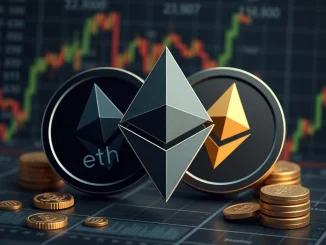
Are you holding crypto that’s currently locked? If so, you might have felt the sting of recent market movements more acutely than others. The stark reality, highlighted by Taran, founder of crypto OTC platform STIX, is that holders of locked tokens have witnessed significant pain over the past year, with values plummeting by approximately 50% on average. This means many investors missed the prime opportunity to capitalize when prices were double what they are today in early 2024.
This situation brings into sharp focus the mechanics of tokenomics and the potential volatility tied to vesting schedules. As Wu Blockchain pointed out, the scale of future releases is immense, with over $40 billion worth of locked altcoins slated to enter the market.
What Exactly Are Locked Tokens and Crypto Vesting?
Before diving deeper into the recent downturn and future outlook, let’s clarify what we mean by locked tokens and crypto vesting. When a cryptocurrency project launches, a significant portion of its total token supply isn’t immediately available on the open market. These tokens are typically allocated to the project team, advisors, early investors (seed, private, public sale participants), and for ecosystem development.
To prevent an immediate sell-off that could crash the price, these allocations are subject to vesting schedules. Vesting is essentially a lock-up period during which tokens are held in smart contracts or controlled wallets, becoming available gradually over time. Think of it like an employee stock option plan, where shares unlock after a certain period of employment.
Common vesting structures include:
- Cliff Period: A period (e.g., 6 or 12 months) during which *no* tokens unlock. After the cliff, a large chunk might unlock, or the linear vesting begins.
- Linear Vesting: Tokens unlock block-by-block or in regular installments (e.g., monthly, quarterly) over a set period (e.g., 1-4 years) after the cliff or from the start.
- Milestone Vesting: Tokens unlock upon the achievement of specific project development milestones.
The purpose? To align the interests of early participants with the long-term success of the project and maintain market stability by controlling supply.
The Pain of Altcoin Losses for Locked Holders
Taran’s observation about the average 50% loss for locked tokens holders over the past year is a stark reminder of the risks involved. While the broader crypto market saw periods of significant gains in late 2023 and early 2024, reaching multi-year highs, many holders with tokens subject to vesting could only watch.
Imagine holding tokens that were trading at $1 just months ago, but you couldn’t sell because they were locked. Now, those same tokens might be trading around $0.50, and they are finally unlocking. The opportunity to realize profits at the peak was missed entirely due to the vesting constraints.
This highlights a critical challenge for investors in early-stage projects: even if the project performs well and the token price surges, you cannot benefit until your tokens unlock. If the market then corrects before your unlock date, your potential gains can evaporate, turning into significant altcoin losses relative to the market peak.
The Looming Threat: Understanding Future Token Unlocks
The $40 billion figure cited by Wu Blockchain represents a massive volume of value waiting to be released into the market. These upcoming token unlocks are not just abstract numbers; they represent potential supply increases for specific altcoins that could influence their price dynamics.
When a large batch of tokens unlocks, the circulating supply of that cryptocurrency increases. According to basic economic principles, an increase in supply, without a corresponding increase in demand, can lead to downward price pressure. Early investors or team members who receive unlocked tokens might decide to sell a portion to take profits, cover costs, or diversify, adding sell pressure to the market.
While not every unlock event leads to a price dump (sometimes the market has already ‘priced in’ the unlock, or demand is strong enough to absorb the new supply), significant unlocks, especially for smaller market cap projects, can act as headwinds, contributing to volatility and potentially exacerbating altcoin losses.
Navigating Crypto Vesting Schedules: What Investors Need to Know
Understanding crypto vesting schedules is not just for early investors; it’s crucial for anyone trading or holding altcoins. Here’s why:
- Supply Dynamics: Vesting schedules dictate the rate at which new tokens enter circulation, directly impacting the token’s supply inflation.
- Potential Sell Pressure: Knowing when large token unlocks are scheduled can give you insight into periods where increased selling activity might occur.
- Project Commitment: Long, well-structured vesting periods for teams and advisors can indicate a project’s commitment to long-term growth rather than short-term gains.
How can you stay informed? Look for the tokenomics section in a project’s whitepaper or documentation. Many projects also publish their vesting schedules transparently. There are also third-party websites that track major upcoming token unlocks across various projects.
The Market Impact of Locked Tokens and Unlocks
The relationship between locked tokens, vesting, and market impact is complex. While the theoretical outcome of an unlock is increased supply and potential price drops, the actual impact varies greatly depending on several factors:
- Market Conditions: In a strong bull market, increased supply from unlocks might be easily absorbed by high demand. In a bear market or period of uncertainty, unlocks can amplify downward price movements.
- Unlock Size: The size of the unlock relative to the current circulating supply and daily trading volume is critical. A small unlock might have negligible impact, while a large one (e.g., doubling the circulating supply) could be significant.
- Recipient Behavior: Who is receiving the tokens? Team members might hold for longer. VCs might sell gradually or strategically. A large number of small private sale investors might lead to more dispersed selling.
- Project Fundamentals: A project with strong development progress, growing adoption, and positive news is better positioned to withstand unlock-related sell pressure than one struggling to meet milestones.
The $40 billion worth of upcoming unlocks is a figure that demands attention. It suggests that for many altcoins, significant supply increases are on the horizon, which could act as an ongoing factor influencing the broader market impact of supply-demand dynamics in the coming months and years.
Actionable Insights for Investors
Given the recent experience of locked tokens holders and the volume of upcoming token unlocks, what steps can investors take?
- Do Your Homework: Always research a project’s tokenomics and vesting schedule before investing, especially in early rounds or smaller cap altcoins. Understand when and how tokens will be released.
- Assess the Risk: Be aware that even fundamentally strong projects can see price dips around major unlock events. Factor this into your risk assessment.
- Look Beyond the Price Chart: Analyze supply schedules alongside price trends. A rising price might look appealing, but if a massive unlock is due, it could face sudden headwinds.
- Consider the Long Term: If you believe in a project’s long-term vision, short-term price volatility around unlocks might present buying opportunities, but only if you’ve done thorough research.
- Diversify: Don’t over-allocate to projects with highly front-loaded or uncertain vesting schedules.
Conclusion: Navigating the Unlocking Future
The past year served as a tough lesson for many holding locked tokens, demonstrating how vesting constraints can lead to significant missed opportunities and painful altcoin losses when markets are volatile. With over $40 billion in future token unlocks on the horizon, understanding crypto vesting schedules and their potential market impact is more critical than ever.
While unlocks don’t guarantee price drops, they represent a significant supply-side factor that can influence individual altcoin performance and contribute to broader market dynamics. For investors, staying informed about vesting schedules and incorporating this knowledge into their research and risk management strategies is essential for navigating the complexities of the crypto market and potentially avoiding future pain.
The future holds significant unlock events, and how the market absorbs this influx of supply will be a key narrative for altcoins. Informed investors are better equipped to understand the risks and opportunities these unlocks present.



